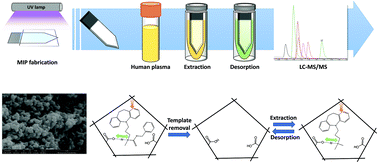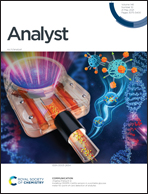Thin film molecularly imprinted polymer (TF-MIP), a selective and single-use extraction device for high-throughput analysis of biological samples†
Abstract
Enhancing selectivity, reducing matrix effects and increasing analytical throughput have been the main objectives in the development of biological sample preparation techniques. A thin film molecularly imprinted polymer (MIP) is employed for extraction and analysis of tricyclic antidepressants (TCAs) as a model class of compounds in human plasma for the first time to reach the abovementioned goals. The thin film MIPs prepared on a metal substrate can be used directly for extraction from biological matrices with no sample manipulation steps and no pre-conditioning. This method was validated with good linearity (R2 > 0.99 in 1.0–500.0 ng mL−1 range), excellent accuracy (90% −110%) and precision (RSD % value less than 15%) in pooled human plasma samples (N = 3). The limits of quantitation (LOQ) for TCAs in plasma samples were between 1.0–5.0 ng mL−1 which are lower than the therapeutic ranges of these drugs. Kinetic and isotherm studies showed the superior performance of MIP sorbent compared to a non-imprinted polymer (NIP) sorbent in extracting TCAs from a bovine serum albumin (BSA) solution. The optimized and validated method for pooled human plasma was utilized for monitoring the concentration of TCAs in three patient samples who had been prescribed TCAs. These selective single-use thin film extraction devices are promising for efficient and fast procedures for analyzing biological samples.

- This article is part of the themed collection: Analyst Recent HOT articles


 Please wait while we load your content...
Please wait while we load your content...